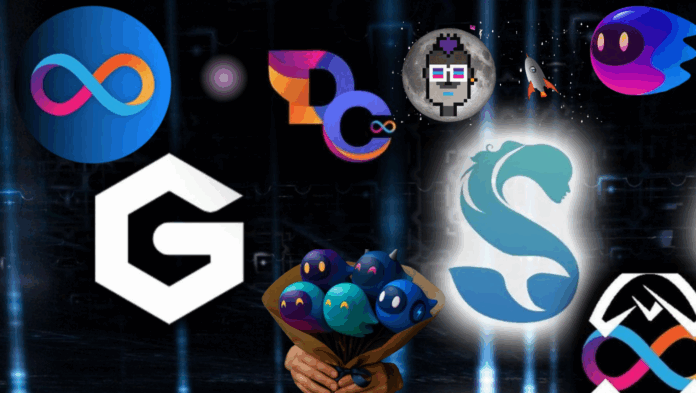The Internet Computer Protocol (ICP) has built one of the most technically capable environments for NFTs in web3. It offers zero gas fees, full on-chain storage, rapid transaction speeds and near-infinite scalability. Wallet integration is seamless, and cross-chain compatibility with ecosystems like Ethereum, Solana and Bitcoin is beginning to take shape. The building blocks are in place. What’s still missing is the consistent cultural momentum to match the infrastructure.
While there are now at least nine active NFT marketplaces on ICP, creative activity and community engagement have yet to reach their potential. Artists, collectors and builders have the tools, but widespread adoption and participation remain patchy. Compared to Ethereum, where creator and collector communities have matured and grown deeply networked, ICP feels early, though not empty.
Entrepot remains the most established marketplace in the ecosystem. Created by ToniqLabs, it supports high-profile collections like Poked Bots, Bitcoin Flowers and Internet Creeps. Toniq itself operates a separate platform, mirroring some functionality and helping onboard new creators.
Impossible Things, developed by the ORIGYN Foundation, targets the luxury segment. It offers authenticated NFTs tied to high-value items like watches and collectibles, including collaborations with WatchBox and the UEFA Foundation. Its cross-chain support includes Ethereum and Solana, placing it in a broader context than most.
Other marketplaces add variety. CetoSwap enables fractional ownership through F-NFTs, hosting projects such as Bobo Eggs and IC Chibi. ICMarket has become the go-to for secondary listings like Starfish NFTs. Hatch supports grassroots generative art, including its own Shellbacks collection and Night Birdz Universe. Gigaverse Labs, which launched early projects like ICPunks, ICats and Infinity Flies, now hosts an expanding roster of community-driven art.
Yumi, a fully decentralised marketplace, stores all data on-chain and supports features like auctions and mystery drops. Recent highlights include the Girls collection by ShuFan, which quickly sold out. Bioniq handles Bitcoin Ordinals NFTs, bridging BTC and ICP via ckBTC. CrowdFund NFT helps launch new projects with pre-sale tools and trusted onboarding.
Still, several platforms listed in older DFINITY documentation are now inactive. Itoka is offline. BitBasel shows no ICP presence in its interface. Canister Store and Kontribute are not operational. That list needs revision, as the centre of activity has clearly shifted.
The technical benefits of ICP are well known. Its reverse gas model allows users to mint, trade and interact without paying gas fees. Instead, platforms absorb minimal network costs (typically 0.0001 ICP per transaction). All NFT data — metadata, images, videos — is stored directly on-chain, avoiding the weaknesses of centralised or IPFS-linked storage seen in Ethereum or Solana projects. The user experience is fast, responsive and consistent.
Wallet support includes Infinity Wallet, Stoic Wallet, Bitfinity Wallet and Internet Identity. Some platforms like CetoSwap require ICP to be wrapped into WICP, though this is handled seamlessly within the interface. The proposed ICRC-7 NFT standard aims to improve interoperability between marketplaces, but adoption remains limited as of mid-2025.
What’s holding ICP back isn’t functionality. It’s activity. Usability issues occasionally affect older platforms like Entrepot and Toniq, and scams remain a risk as in any web3 setting. The DFINITY Foundation regularly warns about phishing attempts and urges users to verify links and keep keys secure. These are solvable. What’s harder to manufacture is cultural buy-in.
That’s where NFTs come in — not as financial tools, but as cultural signals. They enable identity, storytelling and digital ownership. Unlike tokens, which are fungible and interchangeable, NFTs carry meaning because they are traceable, permanent and provably unique. As @punk6529 puts it:
“NFTs are the scarcest cultural objects ever made, the only cultural objects with pristine provenance. They are not BTC, but they will behave over time in ways that emotionally parallel BTC for the $100T in global intangibles.”
In an extended thread, he compared NFTs to the vast yet opaque world of fiat culture: the billions of items sitting in museums and private collections, most of which lack any clear provenance. There are roughly 200,000 objects in MoMA, 615,000 in the Louvre, 1.5 million at the Met, and 157 million at the Smithsonian. UNESCO estimates there are over 100,000 museums globally. Nobody really knows how many objects exist in storage or in circulation — and that’s part of the problem.
What NFTs solve is visibility. They log what was created, when, by whom, how many copies exist, who owns them, and whether any have been burned or faked (none can be). According to @punk6529:
“With NFTs, you know:
a) when they were created
b) who created
c) how many exist
d) who owns them
e) how many are destroyed
f) which are fake (none)”
This changes how we think about culture. What once required trust in institutions can now be verified on-chain. He added:
“Bit by bit, more people will come through to the other side and say ‘wait, it feels risky and fake to own a non-NFT cultural object.’”
ICP is uniquely suited to this shift. It offers tools that can support a provenance-first culture with full transparency, decentralised storage and no user-facing costs. What it lacks right now is a sustained wave of creativity, participation and narrative formation.
There are early signals. Motoko, a community NFT project created by the DFINITY Foundation, celebrates the Motoko programming language and ICP development. Motoko Ghosts, a 10,000-piece collection launched in 2021 by artist Jon Ball, were initially given away to DSCVR users and NFT.NYC attendees. They now command a floor price of several ICP. Motoko Mechs, a follow-up collection of 2,021 NFTs, were airdropped in 2022 to Supernova hackathon participants. They’re fully hosted on-chain and minted with support from Toniq Labs.
Motoko Sentinels, another project by Jon Ball, launched in April 2024 on Bioniq using ckBTC. These 3D-animated NFTs imagine Sentinels as sentient code packets, defending a decentralised universe. They offer a creative reinterpretation of the Motoko Ghosts, extending the lore and tying into Bitcoin-native assets.
Motoko Pal NFTs, though less widely known, continue to serve community engagement efforts. Holders can participate in special events or contests, sometimes earning token or NFT rewards.
Another creative community, GNight Punks, operates across multiple chains but maintains a strong presence on ICP. Their pixel punk designs in night mode use vibrant blockchain colour schemes and emphasise clean aesthetics. The project is less about speculation and more about collective exploration and creative collaboration.
These examples show what’s possible — technically and artistically. What’s missing is scale. Community participation remains low relative to ICP’s capabilities. Most active collectors know each other by name. Drops come and go with little fanfare beyond niche Telegram or DSCVR groups. There is talent, but not yet mass movement.
That’s the gap: ICP has the infrastructure. It has live, functional marketplaces. It has a few standout collections and a handful of developers and creators building with care. The tech stack is one of the best in web3. What needs to catch up is the culture. The experimentation. The risk-taking. The sense of community that turns platforms into ecosystems.
If ICP is to thrive creatively, it needs to encourage more projects like Motoko, GNight Punks, ShuFan’s Girls, and the dozens of smaller collections finding their way into the ecosystem. It needs artists who aren’t waiting for liquidity before launching. It needs collectors who buy because they care. It needs curators, critics, and storytellers to explain why any of this matters.
The structure is there. The pipelines are ready. The wallets work. What comes next is up to the people using it. NFTs might be programmable JPEGs, but they’re also culture. On ICP, they can be verifiably permanent culture — but only if more of that culture actually shows up.


